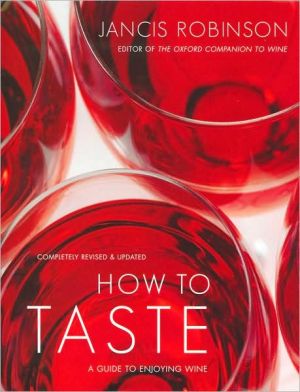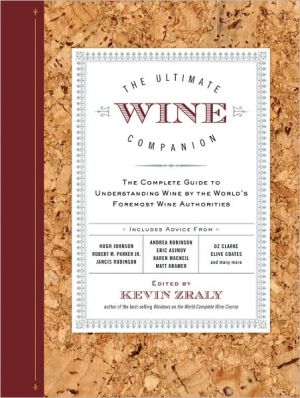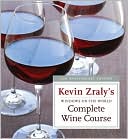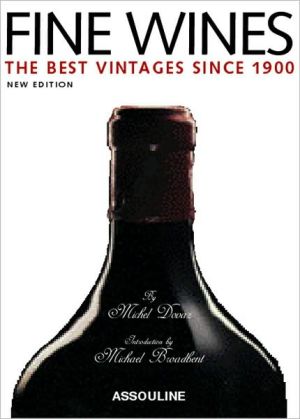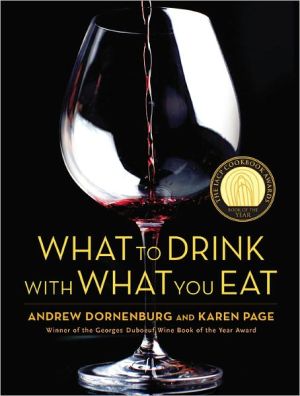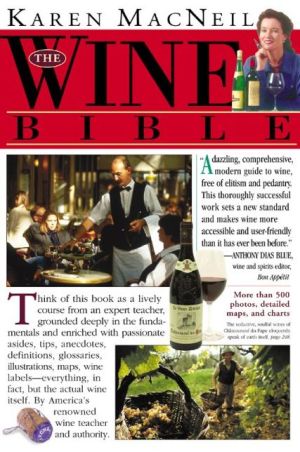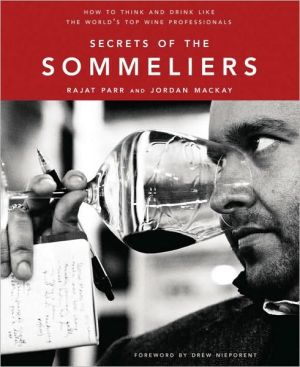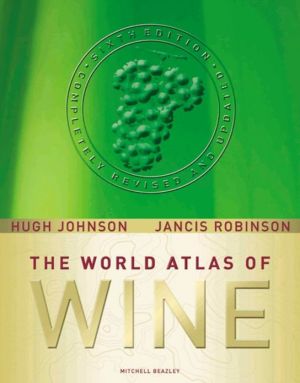How to Taste: A Guide to Enjoying Wine
What better way to learn about wine than to taste it?\ Hailed by Jerry Shriver in USA Today as "the woman who makes the wine world gulp when she speaks," Jancis Robinson created in How to Taste a classic for connoisseurs of all levels and the first introduction of its kind to focus on practical tasting exercises. Now fully revised and updated, Robinson's renowned guide proves once again that learning about wine can be just as engaging as drinking it.\ Written in Robinson's trademark...
Search in google:
What better way to learn about wine than to taste it?Hailed by Jerry Shriver in USA Today as "the woman who makes the wine world gulp when she speaks," Jancis Robinson created in How to Taste a classic for connoisseurs of all levels and the first introduction of its kind to focus on practical tasting exercises. Now fully revised and updated, Robinson's renowned guide proves once again that learning about wine can be just as engaging as drinking it.Written in Robinson's trademark accessible style, the new How to Taste features thoroughly updated vintages and producers as well as up-and-coming wine regions and styles. Incorporating wines that are both easily obtainable and reasonably priced, Robinson's lessons are separated into complementary portions of theory and practice to help you both learn and taste your way to wine expertise.One of the world's best-loved authorities on wine, Robinson explains first how to get the most out of the flavor of your wine and food, and then about specific grapes and the wines themselves. By the time you finish the book, you will have learned how to recognize the most popular grape varieties from Chardonnay and Riesling to Pinot Noir and Cabernet Sauvignon, and why a good sparkling wine is always better than cheap champagne. You will discover how to judge sweetness, acidity, and fruitiness as well as the difference between the length and the weight of a wine. You will also be given practical advice for dealing with wine in the real world: how to choose from a wine list, organize your own wine tastings, and pair wines with specific foods.From the armchair to the wine shop and back to the table, How toTaste will transform anyone on any level into a confident connoisseur who can leave faltering sips behind and have fun along the way.
Foretaste: a book for the thirsty\ This is a book for people who want to know more about wine, but have quite understandably realized that drinking wine is a lot more fun than reading about it. Happily, the practical side of wine appreciation not only has more immediate appeal than the arid theory, it is also considerably more important.\ It's horribly easy for those of us who earn our living writing and talking about wine to lose sight of the fact that what actually counts is how it tastes. T h e lovely liquid exists not to fill analysis books or justify vintage charts, but to give sensual pleasure. This "wet" guide to wine is merely an accompaniment to your wine drinking, explaining why different wines taste the way they do, so that by being an informed wine taster (as opposed to an ignorant drinker) you can maximize your enjoyment.\ This wine tasting workbook constitutes a complete wine course for the thirsty. It tells the story of how wine is made, explains how factors as diverse as climate and bottle size influence the resultant taste, and demonstrates how to get as much pleasure from wine as possible by the practical way you serve and drink it. All this information is offered here not just with words, but reinforced by scores of practical exercises — most involving that important sport, wine tasting. Each chapter is divided into theory and practice sections, so you can first absorb the relevant information and then test it yourself. (Other things you'll be asked to do range from tasting toothpaste to drinking wine from a teacup.)\ The course begins with an outline of our personal tasting mechanism and highlights some surprising facts which may well help you get more out of everything you taste — food as well as wine. This is followed by a detailed look at the practical aspects of serving and drinking wine. However, the main body of the book is the story of wine told by the painless method of tasting it.\ The exercises i n the practical sections are meant to equip the interested wine drinker with the important explanations of why each wine tastes the way it does. Every taste-shaping factor is illustrated with specific examples, and everyone who completes the exercises should have an extremely good grasp of the fundamentals of wine in its most relevant, but often overlooked, context — in your glass. You can literally taste your way to wine expertise. Halfway through the course, you should find that you are able to tell a Chardonnay from a Sauvignon and, by the end, a Medoc from a Coonawarra; making mistakes no more often than the wine professional — that is, no more than half the time.\ There are all sorts of different factors that influence the flavor of a wine, from what goes on fifteen feet below the vineyard to whether the cellar door was left open when the wine was bottled. But the single most important and recognizable factor is thepredominant grape variety that is used i n the wine. For this reason, and because so many of the world's wines are now labeled as varietals (Cabernet Sauvignon, Merlot, Pinot Noir, Chardonnay, Riesling, etc.), the main part of the book is divided into sections on each of the major grape varieties.\ Initially, this is simply to establish each variety's identity on the palate. A Marlborough Sauvignon from New Zealand and a Sancerre, for instance, are examples of the same grape variety, and tasting each (plus a dry white Bordeaux and a Fume Blanc from California) will help form a "palate picture" of the Sauvignon Blanc grape. Grafted on to each section, however, is a set of increasingly complex and interrelated factors. After you've established what Sauvignon tastes like, for example, you are encouraged to taste examples made in very different climates, so that you can see how 50 percent more sunshine i n a bottle actually tastes.\ First of all, we look at the grapes that make "white" wines, then those that make red wines. There follows a guide to tasting sparkling and strong or "fortified" wines such as sherry and port. At the end of the book there are also some demonstrations of why some wine and food combinations don't work (though no dogma about which do), some suggestions for further wine tasting exercises, and a short glossary of the jargon used in wine tasting.\ How to use this guide\ If you want to learn about wine in the speediest and most systematic way that this book can offer, try to follow the exercises in the order suggested in this course, as this constitutes a logical and precise way of building up your knowledge. There's no reason, however, why you should allow me to dictate your wine-drinking habits. You could perfectly easily allow the wine you happen to be drinking to dictate the order in which you tackle this book. Simply look up the wine you are tasting in the index, which starts on page 205, and find out which exercise(s) could be useful.\ Certainly, chapters 3 and 4, on white and red wines respectively, can be tackled in tandem, though even the most free-range wine taster is advised to look first at the two chapters on "Learning to taste" and "Practical matters."\ You can learn a great deal by studying only one wine but, as you will see in this book, you can learn at least five times as much by tasting two and comparing them. This means that you could accelerate your progress through this course by getting together with others also interested in finding out more about wine, or by learning how to cope with wine leftovers, or by dramatically increasing your wine consumption. You, your liver, and your bank balance will determine which of the two latter possibilities is more sensible, but i f you choose the first, bear i n mind that a normal 75cl bottle can supply either six good glasses of wine for drinking or up to twenty samples for tasting.\ In each practical exercise, examples of wines suitable for tasting have been described as specifically as is both necessary and possible. Many of them are widely available and, where possible, not too expensive. It is true, however, that i n some cases, the less you are cheapest California Chardonnay, for example, will not express the essential characteristics of California and Chardonnay nearly as well as one that costs four or five times as much.\ If you really get hooked, you may also want to try some of the more advanced exercises, which, i f done with enthusiasm and at least part of your brain as well as your mouth, will turn you into a seriously well-informed wine taster.\ Why you can be a great wine taster\ No matter how little you know about wine now, you can learn how to taste wine by following this course. It's designed for everyone from the complete novice (nay, teetotaller) upward. I learned a great deal myself while compiling it, so I hope that others, who have been exposed to wine for some years, may do so, too — especially from chapters 1 and 2. Those who are relatively new to wine should feel particularly confident, though, since it is they who invariably make the most acute tasters.\ The average adult can detect well over one thousand different flavors, many of which can be found in wine, so your tasting mechanism is already well equipped to deal with the raw material. All you need is the sort of guidance this course can offer, and some confidence. There is no such thing as a born taster. Only a tiny proportion of people whose physical disabilities have impaired their sense of taste will find any difficulty at all; and in blind tasting (tasting to identify an unnamed wine) novices often do better, because their perceptions are unclouded by previous experiences.\ This course should turn you into an accomplished "blind" taster (one who can identify wines without any clues other than what they taste) but, perhaps more importantly, will show you how to assess the quality of the wine and how to get the most from it.\ Despite what some self-styled "connoisseurs" may suggest, there are no rights or wrongs in wine appreciation. Tasting is in its essence a subjective business. There are some bottles which may, on an objective basis, be technically faulty, but which some tasters may find perfectly enjoyable. There are other famous wines that can count on enough admirers always to command a high price — that most quantifiable of wine measurements — yet they may not appeal at all to all wine drinkers. Never feel that you "ought" to like or dislike a wine. The most important aspect of any wine is that you enjoy it. The aim of this book is to help you enjoy wine more.\ How little we know\ It's extraordinary how little we know about something we do as often as eating and drinking. Once food and drink enter our digestive systems there are so many things that can go wrong that the medical profession knows a great deal about what goes on there. But surprisingly little is known about the process of tasting that precedes all of that, even though we should, in theory, be much more consciously involved in it than in the digestive process.\ Few medical researchers have thought it necessary to look very carefully at how we taste, presumably because a malfunctioning gustatory system is not seen as a particularly serious affliction (though it would drive me crazy). And if the professionals know remarkably little about how the gustatory system operates in its complex role between mind and body, then we ordinary eaters and drinkers understand even less about how to get the most out of the tasting experience. Even those who would claim to appreciate the pleasures of the table have no clear idea how and why they do so. Whether you like chocolate cake, smoked salmon, or Merlot, your general approach will be to ram as much of it as possible into your digestive system (and therefore past your gustatory system) as fast as you possibly can. You are vaguely aware that by chewing the food you can prolong the pleasure it gives you, and that with wine there is some rather unsavory gargling business indulged in by professionals. But that, for most of us, constitutes our knowledge of this daily activity.\ We may not know much about it, but, as so many of us proudly proclaim, we sure do know what we like. Or do we? We reckon it is the taste of food and drink that we recognize and base our judgments on, but experience shows that when we are left without any clues other than our own sense of taste we can be pretty helpless. By examining carefully how it is that we taste, this wine course should leave the reader considerably better equipped to appreciate wine — and food, for we taste solids and liquids in almost the same way; i n fact, physiologically, we can't taste solids until we have transformed them into liquids by chewing them. Experiments show that it isn't possible for us to taste totally dry foods at all, so a well-blotted tongue would have no chance of telling even that sugar was sweet.\ Text copyright © 1983, 2000, 2008 by Jancis Robinson
Foretaste: a book for the thirsty61Learning to taste: how to taste and how to talk about it102Practical matters: the time, the place, storing and serving wine543The raw material: white grapes884The raw material: red grapes1265Strong and sparkling wines1746Wine, food, and fun186Wine and words - glossary198Index205Acknowledgments208
\ From the Publisher"Perhaps the most talented of the world's wine writers...[with a] seemingly infinite ability to fashion informative, accurate books that are essential reading." — Robert M. Parker, Jr.\ "The woman who makes the wine world gulp when she speaks...as unpretentious as Beaujolais Nouveau." — Jerry Shriver, USA Today\ "I have watched her slowly tighten her grip on the wine world with awe...Don't be fooled by her twinkling television persona; her serious purpose is to open the wine world to all comers, at all levels. In the process she has become a household name — for good." — Hugh Johnson\ "The Julia Child of wine." — Peter M. Gianotti, Newsday\ "She is simply the best wine writer working today. No one else comes close to Robinson's combination of tasting acuity, prolific and authoritative writing, and wit." — Stephen Tanzer, International Wine Cellar\ "A thorough, no-nonsense approach to unlocking some of the mysteries of appreciating and enjoying wine." — Frank Prial, The New York Times\ "For those who want to learn how to taste wine, the Robinson approach is hard to beat!" — Gerald D. Boyd, San Francisco Chronicle\ "By a long measure the best wine writer in the world." — Paul Levy, The Wall Street Journal\ \ \
